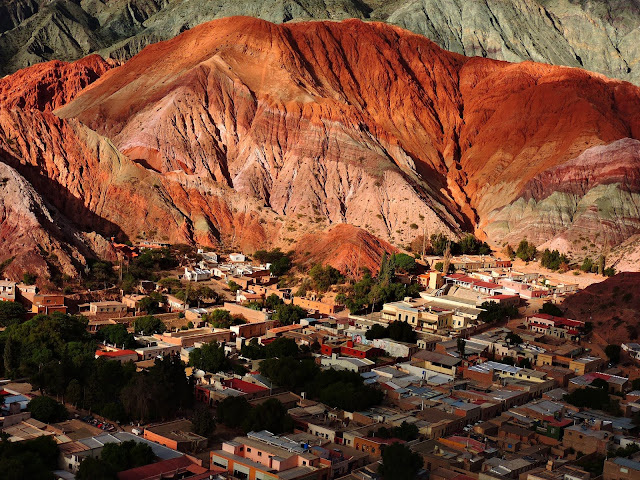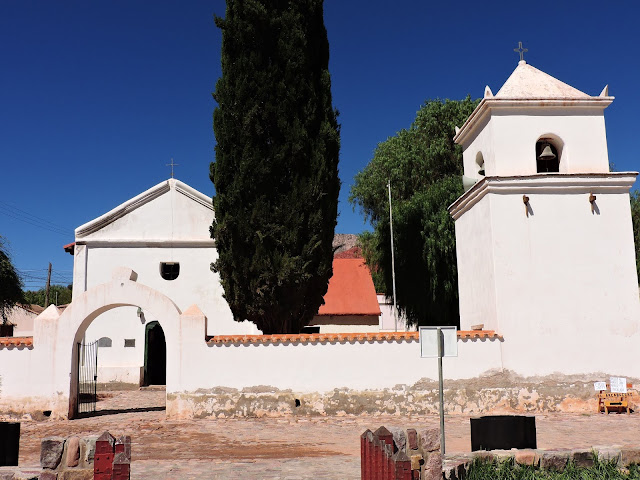The Quebrada de Humahuaca
The Quebrada de Humahuaca is a 155 km long valley that follows the Rio Grande River through the high desert of Jujuy province in north-western Argentina. It has great cultural and historical significance. Early trading societies, caravans of Incan conquerors and soldiers in the War of Independence are just some of the people who have been using the route for over 10,000 years. In 2003 the region became recognized as a UNESCO World Heritage Site.
The landscape throughout the valley is rugged and remarkably beautiful. Although it is a popular holiday destination for Argentinians there are not a lot of foreign tourists. Nobody that we know has ever travelled here and that makes it all the more exciting. The elevation is still relatively high, beginning at 7600 feet and increasing to over 10,000 feet as we work our way from south to north.
Our first stop was the village of Purmamarca, famous for its seven-coloured hills. It didn't disappoint. The various hues are a result of the accumulation of different sediments that date to when the region was underwater 600 million years ago. The first photo is taken from a ridge above the town. The next two are from the Colorado Trail which winds around the back side of the hills leading to more spectacular views.
Our first stop was the village of Purmamarca, famous for its seven-coloured hills. It didn't disappoint. The various hues are a result of the accumulation of different sediments that date to when the region was underwater 600 million years ago. The first photo is taken from a ridge above the town. The next two are from the Colorado Trail which winds around the back side of the hills leading to more spectacular views.
Purmamarca was just what we needed for a relaxing day and a half. We stayed at a lovely old estate home with lots of space and character. Although a little worn out, that was part of the charm as we admired the building style and courtyard features from a very different era and culture. There was always something of interest going on in the town square. Markets ruled the day and at night friends got together to have some fun.
It didn't take long to observe some of the nuances of life in Argentina. It is a very much a late night culture where it is common for restaurants to be closed until 8 PM. It is considered rude to walk past a table where people are dining without wishing them buen rovecho (equivalent to bon appetit). The custom is a reflection of the importance of food and sharing a meal in Hispanic culture.
While poking around in the shops and learning to recognize the bank notes we noticed that coins are rarely available and that the small bank notes are often tattered and torn. When one of the owners couldn't provide the proper change he just offered customers a hand full of candy instead. An early morning walk in the countryside before leaving town enabled me to study some of the local flora (quince fruit tree) and fauna (white-tipped plantcutter bird).
The town of Tilcara is a little larger and makes a good base for exploring the other sights in the region. Nancy and I both liked the feel of it right away. It reminds me of southern Italy with lots of stonework, lovely little gardens and an enduring religious presence. We were quite impressed to see some of the people using metal straws in their drinks.
As elsewhere throughout the valley there are lots of stunning mountain views nearby.
The Pucara de Tilcara is considered to be one of the most important of the numerous Incan ruins in the Quebrada de Humahuaca. It occupies a dramatic location on a hillside overlooking the valley. Little is left of the original structures but an interesting building has been built in honour of the archaeologists who worked on the excavations. It incorporates elements of the Mayan, Incan and Teotihuacan designs which the scientists admired.
Not far from Tilcara there are a few interesting villages. In Uquia the San Francisco de Paula Church (1691) is a simple whitewashed structure but it has a collection of famous canvases, the Arquebusier Angels created by Indigenous painters. When the church was built the local artists were tasked with depicting nine arch angels. When they asked what angels looked like the reply was "similar to Europeans". Relating this to their personal experience they painted the figures carrying arquebusiers (long guns). The large wings are tinged in pink like the feathers of the flamingos which were familiar to them.
Maimara is just 6 km from Tilcara. The name means "falling star" in the language of the Maimarans and Tilcarans who originally populated the area. Vestiges of their culture remain today, including Our Lady of Carmen Cemetery. It was a contributing factor to the special recognition of the area by the United Nations. The cemetery sprawls over a few adjacent and otherwise barren hillsides. Large tombs capture the eye while the spaces in between are replete with simpler graves.
The tombs are distinguished by their prolific floral displays. Traditionally consisting of dried flowers, today many of them are constructed of paper or plastic but they are still beautiful.
Maimara is also known for its colourful backdrop called the Painter's Palette.
During our final day in Tilcara we did a half day hike outside of town. There are many rewarding views from the trail that follows along a gorge. The hillsides are decorated with waves of cacti and skillfully crafted aqueducts. At the end there is a climb down into the section of the gorge known as the Devil's Throat.
Two of our enduring memories of Tilcara will be the flowers and the music. Groups of young people often seem to be on the move and at least one of them invariably has a guitar strung over their shoulder. Tilcara is a small town and there are strategically situated stereos so there always seems to be a Spanish tune playing in the background. We stayed at a very cozy hotel called Antigua Tilcara. The common room always had some pan flute or Spanish guitar and vocals playing softly throughout the day. It was a nice treat!
Our final stop in the Quebrada de Humahuaca was the town of Humahuaca itself, which is the largest community. It has a few features which are impressive. The quaint Cabildo (Town Hall) on the main square has a little tower that houses a statue of San Francisco Solano. Each day at noon a small door opens and the monk springs to life, blessing the people by making the sign of the cross.
One also finds the Monument to the Heroes of the Independence Movement, the Northern Argentine Army, which fought 14 battles against its Spanish overlords, 1820-1823. The amount of masonry work that must have been involved in building the series of staircases that lead up to the monument is extraordinary.
One also finds the Monument to the Heroes of the Independence Movement, the Northern Argentine Army, which fought 14 battles against its Spanish overlords, 1820-1823. The amount of masonry work that must have been involved in building the series of staircases that lead up to the monument is extraordinary.
The bronze sculptures that are the focal work of the monument weigh seventy tons! The design is meant to portray the image of freedom although there is some dispute over which of the native chiefs the main figure is supposed to represent. The emphasis is clearly on the contributions of the native fighters and is therefore considered to be a prime example of Indigenismo, the recognition of the significance of native heritage in Latin America...as opposed to Latinismo which promotes the Spanish contributions.
The view from the the monument provides a lovely sunset view over the town towards the White Cliffs that are located just a few kilometres away.
Che Guevara still gets a lot of attention in Humahuaca. Due to his prominence in the Cuban Revolution many people assume that he was a citizen of that country. He was actually an Argentinian who became radicalized by the poverty, hunger and disease that he witnessed while travelling through the countryside as a young medical student. He went on to fight what he perceived to be the capitalist exploitation of Latin America by the USA, supporting a number of populist movements before being captured and executed by CIA-assisted forces in Bolivia. Time magazine named Che one of the 100 most influential people of the 20th century. In addition to the symbolism on the walls of the town, the very popular Mikunayoc Restaurant has an entire wall of photos, quotes and other memorabilia in honour of the man.
Last, but not least, is the sight that is the main draw for tourists to the area. About a fifty minute drive into the high altitude topography beyond Humahuaca are the fourteen-coloured hills of Hornocal. When I first saw the images while researching the trip I thought, no, they can't really look like that. But they do! One image alone can't capture the whole range of beauty. We both think that the colourful jagged teeth could qualify as one of the Seven Wonders of the Natural World.
While overlooking the hills we encountered a group of seven nuns (not all shown) who were there singing songs of praise. Nancy talked to one of them and discovered that they had been doing some pretty gut wrenching humanitarian work in Argentina, Brazil and Uruguay. This was not to be the last time that we would encounter them. While walking back to our hotel through the narrow streets of Humahuaca we were a little unnerved by the sound of an engine revving and gears grinding directly behind us. We turned to see a big land rover full of blue headdresses rumbling downhill in our direction, two wheels on the road and two on the sidewalk. I would have loved to take a picture but was too busy jumping out of the way! These nuns on the loose reminded us of something from the movie Sister Act!
That's it for now. Thanks for wading through the detail - I hope that you enjoyed the photos!

































Wowzer! Again, your pics are remarkable! Humbling sites and informative history lesson. That market is so colorful and inviting. Looks like you are immersed in a very rich culture. Thank you for sharing the experience!
ReplyDeleteTruely amazing! I feel like I'm reading a National Geographic article!
ReplyDeleteI want to thank you for all the time, effort,and thought you put into your blog. Reading your experiences transports me to another world I know little about. I sure hope you're feeling better and catch some zzzz. Now that I learned my iPad doesn't post my messages to you I'll continue to use Lyn' s tablet so I can keep in better contact. All the best to my intrepid explorer friends.😀
Bro Eddie